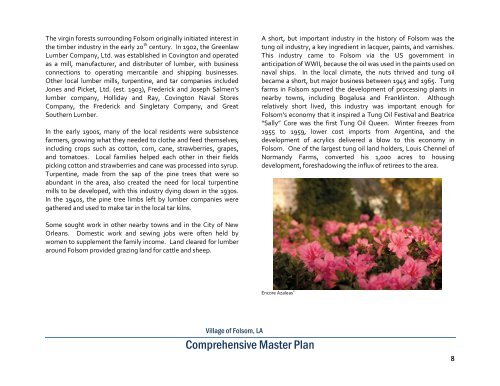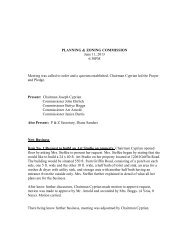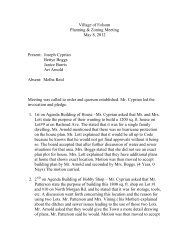Village of Folsom, LA
Village of Folsom, LA
Village of Folsom, LA
You also want an ePaper? Increase the reach of your titles
YUMPU automatically turns print PDFs into web optimized ePapers that Google loves.
The virgin forests surrounding <strong>Folsom</strong> originally initiated interest in<br />
the timber industry in the early 20 th century. In 1902, the Greenlaw<br />
Lumber Company, Ltd. was established in Covington and operated<br />
as a mill, manufacturer, and distributer <strong>of</strong> lumber, with business<br />
connections to operating mercantile and shipping businesses.<br />
Other local lumber mills, turpentine, and tar companies included<br />
Jones and Picket, Ltd. (est. 1903), Frederick and Joseph Salmen’s<br />
lumber company, Holliday and Ray, Covington Naval Stores<br />
Company, the Frederick and Singletary Company, and Great<br />
Southern Lumber.<br />
In the early 1900s, many <strong>of</strong> the local residents were subsistence<br />
farmers, growing what they needed to clothe and feed themselves,<br />
including crops such as cotton, corn, cane, strawberries, grapes,<br />
and tomatoes. Local families helped each other in their fields<br />
picking cotton and strawberries and cane was processed into syrup.<br />
Turpentine, made from the sap <strong>of</strong> the pine trees that were so<br />
abundant in the area, also created the need for local turpentine<br />
mills to be developed, with this industry dying down in the 1930s.<br />
In the 1940s, the pine tree limbs left by lumber companies were<br />
gathered and used to make tar in the local tar kilns.<br />
A short, but important industry in the history <strong>of</strong> <strong>Folsom</strong> was the<br />
tung oil industry, a key ingredient in lacquer, paints, and varnishes.<br />
This industry came to <strong>Folsom</strong> via the US government in<br />
anticipation <strong>of</strong> WWII, because the oil was used in the paints used on<br />
naval ships. In the local climate, the nuts thrived and tung oil<br />
became a short, but major business between 1945 and 1965. Tung<br />
farms in <strong>Folsom</strong> spurred the development <strong>of</strong> processing plants in<br />
nearby towns, including Bogalusa and Franklinton. Although<br />
relatively short lived, this industry was important enough for<br />
<strong>Folsom</strong>’s economy that it inspired a Tung Oil Festival and Beatrice<br />
“Sally” Core was the first Tung Oil Queen. Winter freezes from<br />
1955 to 1959, lower cost imports from Argentina, and the<br />
development <strong>of</strong> acrylics delivered a blow to this economy in<br />
<strong>Folsom</strong>. One <strong>of</strong> the largest tung oil land holders, Louis Chennel <strong>of</strong><br />
Normandy Farms, converted his 1,000 acres to housing<br />
development, foreshadowing the influx <strong>of</strong> retirees to the area.<br />
Some sought work in other nearby towns and in the City <strong>of</strong> New<br />
Orleans. Domestic work and sewing jobs were <strong>of</strong>ten held by<br />
women to supplement the family income. Land cleared for lumber<br />
around <strong>Folsom</strong> provided grazing land for cattle and sheep.<br />
Encore Azaleas x<br />
<strong>Village</strong> <strong>of</strong> <strong>Folsom</strong>, <strong>LA</strong><br />
Comprehensive Master Plan<br />
8




